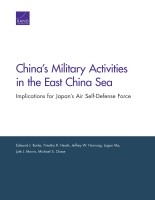| 来源类型 | Research Reports
|
| 规范类型 | 报告
|
| DOI | https://doi.org/10.7249/RR2574
|
| ISBN | 9781977400987
|
| 来源ID | RR-2574-AF
|
| China's Military Activities in the East China Sea: Implications for Japan's Air Self-Defense Force |
| Edmund J. Burke; Timothy R. Heath; Jeffrey W. Hornung; Logan Ma; Lyle J. Morris; Michael S. Chase
|
| 发表日期 | 2018
|
| 出版年 | 2018
|
| 页码 | 44
|
| 语种 | 英语
|
| 结论 |
China and Japan have experienced a dramatic increase in nonlethal encounters between military aircraft near Japan- Chinese military aircraft have flown with increasing frequency near the Senkaku Islands and the Miyako Strait, which Chinese strategists regard as a critical passageway through the first island chain.
- The higher rate of activity has spurred Japan to adjust deployments and increase its acquisitions to keep pace with the growing Chinese presence and defend what Japan views as its airspace.
Military improvements are Japan's most significant effort to push back on China's increased air activities- The Japanese government has prioritized a defense posture more focused on the region and the procurement of assets meant to strengthen the capabilities of the Japanese Self-Defense Force in island defense.
- It has also increased the Japan Coast Guard (JCG) budget and established a JCG patrol unit tasked specifically with patrolling the Senkaku Islands.
The stress of constantly responding to the Chinese air activities has added pressure to an already overstretched Japanese Air Self-Defense Force (JASDF)- The increased operational tempo exacerbates maintenance issues, as the frequency with which aircraft require inspections and maintenance is increasing.
- Although the real-world experience that JASDF pilots are gaining is useful, the increased incursions into Japanese airspace are also negatively impacting pilot training, as pilots are unable to devote this time to the study of other missions.
|
| 摘要 |
- U.S. and Japanese officials should exchange views on ways that Japan could respond quickly and effectively to any surge scenarios involving sudden, large numbers of Chinese military aircraft flight operations near Japan.
- The allies should include the issue of Japanese reprioritization of assets to the southwestern region in their discussions of U.S. force realignment.
- U.S. officials can share experiences of how scrambling protocols evolved during the Cold War to meet the changing situation.
- The United States should work with Japan to train in how to rely on existing and planned ground-based air defenses as a suitable and appropriate counter to some Chinese air incursions.
- Japan might also want to consider cross-domain and bilateral responses with other nations in its efforts to counter Chinese intransigence.
|
| 主题 | Air Defense
; Aviation Maintenance
; China
; Fighter Aircraft
; Japan
; Military Strategy
|
| URL | https://www.rand.org/pubs/research_reports/RR2574.html
|
| 来源智库 | RAND Corporation (United States)
|
| 引用统计 |
|
| 资源类型 | 智库出版物
|
| 条目标识符 | http://119.78.100.153/handle/2XGU8XDN/108915
|
推荐引用方式
GB/T 7714 |
Edmund J. Burke,Timothy R. Heath,Jeffrey W. Hornung,et al. China's Military Activities in the East China Sea: Implications for Japan's Air Self-Defense Force. 2018.
|
|
文件名:
|
x1543843732335.jpg
|
|
格式:
|
JPEG
|

|
文件名:
|
RAND_RR2574.pdf
|
|
格式:
|
Adobe PDF
|
除非特别说明,本系统中所有内容都受版权保护,并保留所有权利。